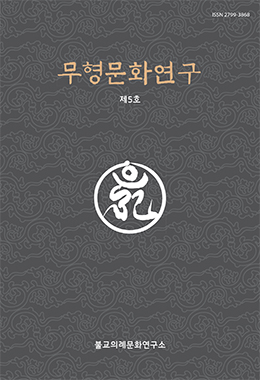본 연구는 예수재와 수륙재의 차이를 드러내기 위하여 두 가지 접근법을 제시한다. 첫째는 유래와 인물의 상징을 통하여 봉행 목적과 의미 차이를 드러내며, 둘째는 봉은사 예수의문과 삼화사 수륙의문의 차이를 알기 위해 대상과 의례 구조, 중심 의례와 주변 의례의 역할 관계를 파악한다.
수륙재는 아난의 염구아귀의 구원이 사생육도의 중생의 구제로 확대된다. 또한, 양무제의 황후를 위한 구제의 발원에서 참회와 헌공을 통해 공덕을 성취하여 법계중생에게 회향하는 이타행의 실천으로 표현된다.
예수재는 병사왕의 명부체험을 통해 역수(逆修) 의례의 공덕을 드러낸다. 이는 봉행 재자로 하여금 그릇된 삶을 성찰하게 하여 올바른 계행과 보시행의 길을 가도록 제시한다.
병사왕과 양무재는 두 의례에서 두터운 신행을 상징하는 인물이며 봉행 재자들은 의례로 인해 그들의 공덕과 동일시되는 효과를 지닌다.
예수의문은 명간목록의 명부 대상이 중시되어 소청과 헌공이 이루어진다. 또한, 하단의 명간지전(冥間之錢)과 경전의 환납 의식이 부각되는 등 주로 봉행 재자의 공덕 성취에 의례의 중심이 있다.
수륙의문은 사생육도 일체중생의 고통을 구제하는 하단의례가 중시된다. 이를 위해 먼저 성위와 일체 중단 대상을 소청하고 헌공함으로써 하단 대상의 제도를 위한 공덕의 기반을 마련한다. 먼저, 대령과 시련 등이 사전의식으로 배치되고 하단의 본 의식에서는 24청사로 이루어진 소청영혼, 관욕, 시식, 수계, 송경 등의 장대한 하부의례를 갖추어 설행된다.
예수재는 신앙회복을 통한 자리(自利)의 공덕행이, 수륙재는 법계 중생을 향한 이타(利他)의 실천행이 특히 강조되고 있다.
This study proposes two approaches to reveal the difference between yesujae and Suryukjae. The first reveals the difference in the purpose and meaning of the service through the origin and symbol of the person, and the second examines the relationship between the object and the ceremonial structure, the central ceremonial and the surrounding ceremonies to understand the difference between the yesujae courtesy of Bongeunsa Temple and the Suryukcourtesy of Samhwasa Temple.
In the case of Suryukjae, the salvation of Anan's Yeomgumaw is expanded to the salvation of the living beings of the Sasaengyukdo. In addition, it is expressed as the practice of altruism, which achieves merit through repentance and dedication in the petition for relief for the Empress of the Emperor Yang Wu, and returns to the sentient beings in the legal world.
The yesujae reveals the merits of the ritual of reversal through the experience of the list of soldiers. This instructs the magistrate to reflect on the wrong life and take the right path of precept and charity.
The King of sickness and death and Mujae Yang are the figures who symbolize the strong deeds in the two ceremonies, and the magistrates have the effect of being identified with their merits through the rites.
For the question of Jesu, the object of the list in the inscription list is emphasized, and petitions and donations are made. In addition, the ceremony is centered mainly on the achievement of merits and deeds of magistrates, such as the ceremonies of giving back the sutras and the Myeongganjijeon (冥間之錢) at the bottom.




